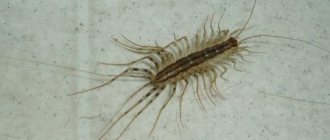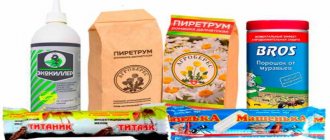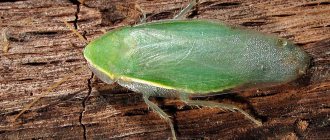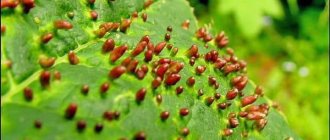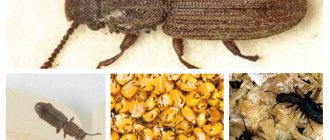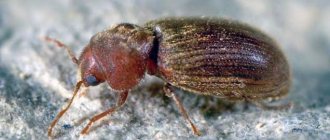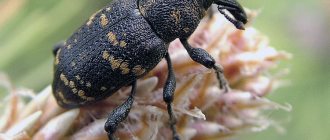What kind of bugs are these?
Many people faced with this problem are concerned about one question - what kind of parasites are these?! Small black or brown bugs that live in the apartment are called skin beetles. They enter the room in several ways - through windows, ventilation holes, cracks in the floor and walls, as well as through clothing, shoes and hair. An adult insect has an oval body shape, the length of which does not exceed 5 mm. It practically does not move, and in times of danger it completely freezes. If you touch the skin beetle with your finger, it will roll over onto its back. Most often, residents of apartment buildings become acquainted with them.
To lay eggs, leather beetles choose surfaces with a fleecy or rough texture - wool, carpets, fur, and various fabrics. Breeding time is from April to June. The female lays eggs for 2-10 days. Their largest number is almost a hundred during the period. The eggs are white in color, up to 2 mm long, and very soft and pliable to the touch. The duration of their development ranges from 2 to 60 days - the exact period is affected by air temperature. Having emerged from the cocoon, the newborn bugs almost immediately set off in search of a partner for mating. In one year, a whole generation of insects can appear in an apartment! Interestingly, the female, having completed her mission, immediately dies.
Carpet beetles prefer to live in well-lit places, so they can be seen on the windowsill or in lamp shades. But they are not at all attracted to moisture in toilets and bathrooms.
Where do pests come from and where do they live in the apartment?
In city apartments, skin beetles appear more often in the summer, since at this time of year they easily enter the room through open windows. They are also brought into homes along with upholstered furniture, books, herbariums and collections. There are also cases when it turns out that leather beetles appeared in the house along with a flower pot, purchased in a store.
If you have such pests in your apartment, you need to understand where they live and how to deal with them. Much depends, of course, on the species. For example, carpet beetles do not have any specific habitat. They simply choose a few hard-to-reach places where no one will disturb them, and then lay larvae there that feed on dust. Smirnova's Kozheed beetle loves not only window sills, but also lamps - it can often be found inside lampshades.
In nature, such bugs are distributed literally everywhere; they avoid only the coldest and dampest regions. But most of the species live in semi-desert and desert areas. Therefore, they are attracted to dry, even overdried air in homes. In winter, people themselves create ideal conditions for them, since at this time of year the optimal microclimate for insects is formed behind the central heating radiators. These pests live on window sills, in dresser drawers and closets, in sofas and mattresses. To get rid of these insects, you first need to understand what attracts them most.
Classification of domestic skin beetles
There are several types of carpet beetles. Some settle in living rooms or bedrooms, while others move into the kitchen and spoil food supplies. Only the larvae pose a danger to people - they begin to actively feed immediately after birth. But adult beetles eat only plant sap or nothing at all.
- Carpet moths are dark brown individuals that feed on house dust;
- Ham - in the European part of the world this is the most popular type of beetle. Its main distinguishing feature is its body shape - long, with yellow spots on top; Smirnov's carpet beetles - these small bugs, more often than other species, settle in apartments; House or museum bugs - hide in flowerpots; Fur bugs - the most harmful type, eats homemade products, It is distinguished by its black spotted coloring.
The beetles of the fur coat beetle are brighter in color than the beetles of the carpet beetle.
To make it easier for you to recognize these bugs, we provide you with photos and names for them.
Larvae also have their own classification:
- Anthrenus - found on clothing and other fabric surfaces; Attagenus - found in bulk products, on carpets, at the bottom of drawers and bags, under parquet boards.
Interesting! Skin beetle larvae will not tolerate bright lighting - they live in dark places.
What are the different types of kitchen pests?
Types of bugs that live in the apartment
The bugs that attack supplies in the apartment are generally similar to each other. They are all small, their colors range from red to dark brown and black. Taste preferences differ slightly: some love flour and small cereals, while others will not refuse beans, cookies and even wood.
There are a lot of insects living in apartments. The most common among them are:
- Red flour eater. Tiny bugs, not exceeding 2 mm in length. They are light brown or red in color and have hard wings. Their small white larvae are almost invisible in dry bulk products. Cereals and flour where such pests have appeared must be thrown away.
- Flour beetle. The bugs are brown in color, with antennae 2-3 mm long. The foods they eat clump into clumps.
- Bread grinder. Especially voracious brown insects that live in kitchen apartments are covered with shaggy hairs. Their body is no more than 4 mm in length.
- Food moth. Adult representatives of these small insects in the kitchen reach a length of 1 cm. Most often they settle in pasta, cocoa, tea, and do not refuse to eat dried fruits.
- Granary weevil. The beetles are dark brown in color with defective wings. They grow no more than 4 mm in length. On the front of their head they have a protrusion that resembles a long proboscis.
- Grains. Black insects with yellowish legs and antennae. They have spots on the back and elytra.
- House ants. Unlike forest ones, these are very small brown ants in the apartment.
- Common silverfish. In everyday life it is called a sugar bowl; this insect has a flat body, tapering towards the end.
Whatever type of pest is found in the dining room, it must be dealt with. The longer you ignore the appearance of insects in your apartment, the more they will multiply, spoil more food, and the more difficult it will be to destroy them. Therefore, having met one representative of this species, it is necessary, without delaying until tomorrow, to take decisive action.
Favorite habitat of insects
Insects in the kitchen love to live in cereals and flour
Kitchen pests thrive in temperatures between 15°C and 30°C.
The red flour eater likes flour and small cereals, such as semolina, corn, wheat, and barley. He also does not refuse rice, buckwheat, cookies, crackers, and compote mixture. The flour beetle loves to live in flour or starch. As they multiply, the insects take over new territories and move into other finely ground grains.
The bread grinder prefers loose leaf tea, instant coffee, beans, peas, nuts, and tobacco as food. Besides food, he loves wood from kitchen cabinets and book pages.
Granary weevils most often attack rice, wheat, barley, and rye. Much less often, insects in the kitchen settle in corn, buckwheat, flour or pasta.
Caryopsis attacks legumes: peas, beans, beans.
Sugar silverfish live in dark, warm, damp places. The bathroom is well suited for this. She feeds on sugar, flour, glue, and wet paper.
Pet food bags are also suitable habitats for most kitchen pests, so they should be tightly sealed and kept in a cool, dry place.
Damage caused by bugs and danger to human health
Indoor insects lay larvae and leave excrement in the food in which they live. If all this gets into the human digestive tract, he will become poisoned. Therefore, if you find at least one pest in a container with cereals, all its contents must be thrown away. To think that a single guest wandered here by chance is a big misconception. While the adult kitchen parasite is difficult to see, its white or transparent larvae are even more difficult to discern with the naked eye.
Are skin beetles dangerous?
Domestic skin beetles cause great harm. They can ruin the entire supply of dry foods, as they easily penetrate even tightly closed jars of cereals or flour. These bugs live in bread bins and cabinets. Of course, you can try to clean the cereal from insects, but there will still be eggs, so you will have to throw everything away.
Books and stacks of papers also suffer from bugs - leather beetles are considered the most dangerous enemies of archives, museums and libraries. The danger zone includes carpets, natural fabrics, products made from wool, fur, skins, horns, feathers, hair, down and felt - bugs will immediately spoil them. In this case, they act no worse than moths - they cut off the fibers and gnaw through entire holes.
The excrement of these small bugs is also dangerous to human health. Once in the body along with food, they can lead to the development of an allergic reaction. Its main manifestations are coughing, asthma attacks, redness of the skin and the appearance of a small rash.
But there is no need to be afraid of skin beetle bites - despite the “telling” name, human skin is of no interest to them. These insects bite only in certain situations - for example, during a sudden change in environmental conditions, repairs and moving.
How to remove brown bugs?
How to get rid of brown bugs in an apartment? Act immediately, without waiting for parasites to start spoiling your things! There are several ways to kill these insects. Let's look at each of them.
Method 1. Insecticides for skin beetles
Chemical agents allow you to very quickly destroy all the bugs. You can safely use:
- Anti-moth preparations – “Raid”, “Antimol”, “Raptor”, “Clean House”, “Armol”. With their help, you will destroy the bugs in literally 2 hours. The only drawback is that skin beetles quickly develop immunity to these poisons, and many chemicals have no effect on them at all. If this happens, repeat the treatment after a few days, using an insecticide with a different composition.
- Powders (dusts) kill not only adults, but also larvae. Such products are rubbed into fabrics and furniture upholstery, and also scattered on floor coverings. If desired, the dust can be diluted with water, poured into a container with a spray bottle and poured into hard-to-reach crevices.
- Anti-moth tablets and fumigators – “Nimol”, “Molemor”, “Antimol”, “Dezmol”. The tablets are laid out on the shelves of the cabinets, and the fumigators are plugged into sockets - one for each room. When using this method, be very careful - by impregnating clothes, tablets and fumigators with their smell, they can cause unpleasant consequences and allergies.
- Aerosols – “Difox”, “Raid”, “Molemor”, “Clean House”, “Dichlorvos”, “Raptor”. To remove skin beetles from clothing and fur products, treat the item with an aerosol, then place it in a plastic bag for 4-5 hours. It is during this period that all flying bugs will die. Upon completion of processing, remove the product to fresh air for long-term ventilation. Aerosols are also suitable for disinfestation of the entire apartment. It should be applied at a distance of about 20 cm from the surface. Usually one procedure is enough to completely destroy insects. If, after some time, new individuals appear in the room, it means that the eggs have survived, and therefore the treatment must be repeated.
- Microcapsule concentrates for sprays - “Difos”, “Foxid”, “Executioner”, “Mittoks”, “Get”, “Morimol”, “Supronit”. Each spray contains an insecticide that has a contact effect. Getting on the chitinous shell, the poison causes paralysis and leads to the rapid death of the skin beetle. The listed preparations provide reliable protection for the premises for a whole year and do not require re-treatment - newly hatched larvae of brown beetles will die immediately.
- Boric acid - the powder of this powerful insecticide should be scattered around the entire perimeter of carpets, as well as on the windowsill and under the baseboards. This product is completely safe for humans, but if you have small children or pets, be very careful. There are cases where boric acid led to food poisoning and allergies.
The most effective are drugs based on allethrin, chlorpyrifos and bendiocarb. These chemicals are ideal for disinfecting carpets as they do not leave behind stains. Before applying the insecticide, the surface must be thoroughly vacuumed. During the pest control process, be sure to treat the walls and backs of furniture. This should be done at a height of 1.5 m from the floor - applying the product higher is useless - bugs do not live there.
When using insecticidal preparations, do not forget to be careful. The presence of protective equipment (rubber gloves, masks, clothes with long legs and sleeves) is a must! At the end of the process, the room should be well ventilated and wet cleaned. Rinse especially thoroughly those areas that come into contact with your hands. Everything else can be left untouched for now in order to extend the time of the insecticidal effect.
Advice! If you use a chemical insecticide in the kitchen, be sure to store the food in the refrigerator or sealed bags.
Method 2. Freezing
Another common and quite effective method for removing brown bugs. If they are in your home, cool the room to -11 degrees. Maintain this mode for at least 3 hours. Carpet beetles are heat-loving insects, so they are unlikely to survive severe frosts. Small items that brown bugs might like should be taken out into the cold or placed in the freezer for about 3 hours.
Unfortunately, this method has several disadvantages. Firstly, flying bugs can reliably hide in some secluded and warm place, keep warm and stay alive. Secondly, freezing will have to be repeated several times, otherwise the effect will not be achieved. Thirdly, it is necessary to carefully prepare the room before the start of the procedure - cover household appliances, remove indoor plants and insulate the heating system. Otherwise, you will face considerable damage.
Method 3. Folk remedies
Natural recipes give good results, but are most often used for preventive purposes:
- Place cotton pads soaked in essential oil of lavender, lemon balm or tansy in your apartment;
- Dilute 1 tbsp. l. vinegar in 1 liter of hot water, pour the liquid into a container with a spray bottle and spray cabinets, window sills, shelves and baseboards; Permethrin pyrethroid. Buy the product at the pharmacy, dilute it in water and use it to soak fur and wool items that have bugs in them.
Fragrant products only repel skin beetles, but do not kill them.
Method 4. Physical destruction
General cleaning will help you get rid of brown bugs in the early stages. If you start it on time, insecticide treatment may not be necessary.
- Inspect everything that is in your home; Take a good vacuum cleaner over all surfaces - this will get rid of not only adult insects, but also larvae. Be especially careful in areas where there is a lot of debris and dust. After cleaning, shake out the contents of the bag outside and wash in hot water;
- Wash all surfaces from baseboards to flowerpots with water with the addition of soap base, vinegar or ammonia; Put everything that can be washed in the washing machine set to the highest temperature, and then iron it with a hot iron. Pay special attention to seams and folds.
Washing in hot water and then ironing the clothes will help get rid of skin beetle larvae and eggs.
Advice! For preventive purposes, wash the floors with a vinegar solution for another 3-4 days.
Grinder
There is another type of harmful bugs that appear in the kitchen. They are called Grinders (“Anobiidae” in Latin). Their head is shaped like a hood. Their body color ranges from dark yellow to brown. There are two types: brownie and bread.
In our cities, as a rule, there is a bread grinder. It is smaller in size than the brownie and, in addition to wood, feeds on bread and crackers.
It can also lay eggs in books. Let's figure out how to get rid of bugs in the kitchen.
How to fight
- Seal all the wooden cracks - the floor, the window sill, the cracks in the kitchen furniture, in general, everything you find.
- Seal the entire cereal hermetically. No bags, only dishes that are sealed tightly.
- They love sweets and carbohydrates. It is better to put all dried fruits in the refrigerator.
- Place borax on the shelves; you can buy it at the pharmacy. But spraying with various chemicals is not the best solution.
If there are bugs in the cereal, this is not a sign of poor quality cleaning in the residential area. The bug appears for other reasons. To effectively combat it, you need to follow a number of simple recommendations. Preventive measures will help get rid of insects in cereals, preventing severe infestation.
The main factor that leads to the emergence of pests in flour and cereals is low quality and the complete lack of heat treatment or insufficiently high temperatures during this process. Another reason is violation of storage conditions for flour and cereal products. Because of this, beetles are found in rice or semolina, and in sealed packages.
Things are much simpler with loose products. At the same time, bugs appear in cereals more often, since they are close to contaminated flour. In the kitchen, insects switch to clean food as a result of loose lids on storage containers. Bugs can appear even if you purchase clean cereals, however, if you borrow even a small amount of contaminated flour, rice, or buckwheat from your neighbors, it is highly likely that the insects will now spread to other products in the kitchen.
If you find some bugs in flour: you need to determine their type as quickly as possible and begin eliminating them
Moreover, pests choose not only cereals, but also dried fruits, tea, coffee, and spices to infest. Most dry foods become contaminated using the methods described above. If there are bugs in the cereal, they are difficult to notice due to their very small size, especially when the dry product is dark in color and has large fractions.
How to eliminate skin beetles in the kitchen?
What to do if small brown bugs appear in the kitchen? The same methods apply to them as to moth larvae:
- Wipe down all cabinets containing food supplies with a damp cloth. Add a little ammonia or vinegar to the water; Check flour, nuts, cereals and dried fruits. Anything that is heavily contaminated should be thrown away. The rest can be processed by heating in the oven or placing in the freezer for three to four hours. Then the cereals are washed well and dried. Of course, this won’t work with flour - you’ll have to get rid of it anyway; Place any remaining supplies in airtight containers.
The process of fighting brown bugs is complicated by the fact that these insects lead a predominantly hidden way of life. Young individuals are more sensitive to poisons, so do not delay the start of the fight. The most productive period is considered to be from May to October.
Prevention of skin beetles
To never again encounter the appearance of small brown bugs in your apartment, do not forget about prevention:
- In the summer, protect the windows with fine mesh nets; Place the same nets for ventilation; Cover all cracks or crevices with polyurethane foam or plaster; Make cosmetic repairs Before sending seasonal items for storage, spray them with a light solution of permethrin. When you want to wear it again, wash it first;
- Periodically arrange sudden temperature fluctuations; Spray fur coats and hats with an aerosol and place them in bags before storing; Ventilate the room at any time of the year; Inspect clothes and interior items from time to time; Keep the house clean.
See also: How to properly store cereals to prevent bugs?
Source
